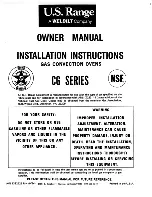
48
49
CLEANING
Make sure you unplug the appliance from the power supply.
1. Clean the cavity of the microwave after use with a slightly damp cloth.
2. Clean the accessories in the usual way in soapy water.
3. The door frame and seal and neighbouring parts must be cleaned
carefully with a damp cloth when they are dirty.
4. Do not use harsh abrasive cleaners or sharp metal scrapers to clean
the microwave door glass as they can scratch the surface, which may
result in the glass shattering.
5. Cleaning Tip: For easier cleaning of the cavity walls that can be
touched by the food cooked, place half a lemon in a bowl, add 300
ml (1/2 pint) water and heat on 100% microwave power for 10
minutes. Wipe the microwave clean using a soft, dry cloth.
UTENSILS
CAUTION!
Personal Injury Hazard
It is hazardous for anyone other than a competent person to carry out any
service or repair operation that involves the removal of a cover which gives
protection against exposure to microwave energy.
See the instructions on “Materials you can use in microwaves or to be avoided
in microwaves”. Certain non-metallic utensils may not be safe for microwave
use. If in doubt, you can test the utensil in question following the procedure
below.
Utensil Test:
1. Fill a microwave-safe container with 1 cup of cold water (250 ml)
along with the utensil in question.
2. Cook on maximum power for 1 minute.
3. Carefully feel the utensil. If the utensil is warm, do not use it for
microwave cooking.
4. Do not exceed 1 minute cooking time.
Materials you can use in microwaves:
UTENSILS
REMARKS
Browning
dish
Follow the manufacturer’s instructions. The bottom of the browning
dish must be at least 3/16 inch (5 mm) above the turntable.
Incorrect usage may cause the turntable to break.
Dinnerware
Microwave-safe only. Follow the manufacturer’s instructions. Do not
use cracked or chipped dishes.
Glass jars
Always remove the lid. Only use to heat food until just warm. Most
glass jars are not heat resistant and may break.
Glassware
Heat-resistant oven glassware only. Make sure there is no metallic
trim. Do not use cracked or chipped dishes.
Oven cooking
bags
Follow the manufacturer’s instructions. Do not close with a metal tie.
Make slits to allow the steam to escape.
Paper plates
and cups
Use for short cooking/warming only. Do not leave microwave
unattended while cooking.
Paper towels
Use to cover food for reheating and absorbing fat. Use with
supervision for short cooking only.
Parchment
paper
Use as a cover to prevent splattering or as a wrap for steaming.
Plastic
Microwave-safe only. Follow the manufacturer’s instructions. Should
be labelled “Microwave Safe”. Some plastic containers soften
as the food inside gets hot. “Boiling bags” and tightly closed
plastic bags should be slit, pierced or vented as directed on the
packaging.
Plastic wrap
Microwave-safe only. Use to cover food during cooking to retain
moisture. Do not allow plastic wrap to touch food.
Thermometers
Microwave-safe only (meat and sugar thermometers).
Wax paper
Use as a cover to prevent splattering and to retain moisture.




































